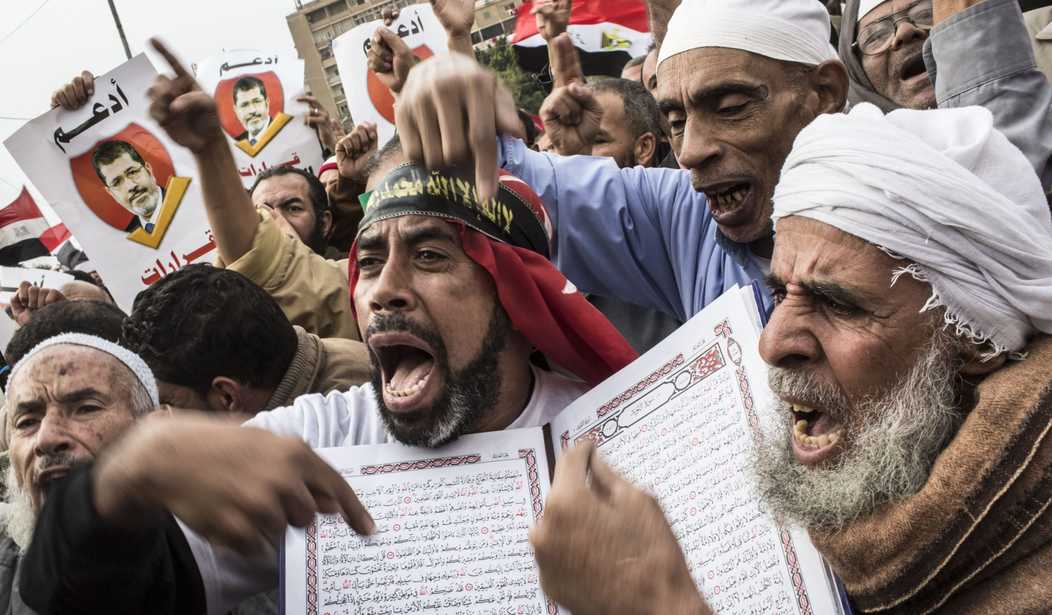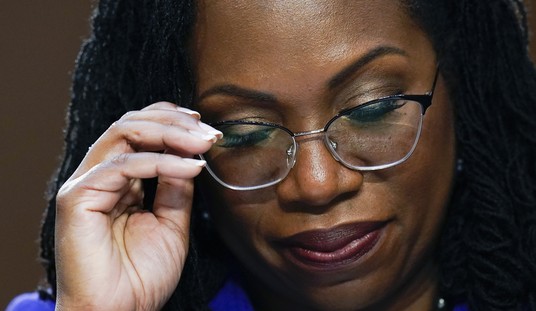Yesterday, I published here at PJ Media the first part of my exclusive interview with former top Egyptian counter-terrorism official Khaled Okasha. This interview with Okasha, who is now director of the Cairo-based National Center for Security Studies and a frequent international media commentator on Egyptian security affairs, was arranged by the Center for Africa and Near East GeoSecurity Studies:
EXCLUSIVE: Former Egyptian Terrorism Official Exposes the Muslim Brotherhood's Terror Networks (Pt 1) https://t.co/U8rJd4ViWF @PJMedia_com pic.twitter.com/nGnuiBPNsq
— Patrick Poole (@pspoole) May 15, 2017
In the first part of the interview, Okasha explored the long-time double game that the Muslim Brotherhood plays with respect to terrorism. He then explored the internal crisis within the Brotherhood following the June 30, 2013, Tamarod protests that led to Muslim Brotherhood President Mohamed Morsi’s ouster just a few days later.
One of the consequences of the Muslim Brotherhood’s loss of power in Egypt was the commissioning of one of their senior leaders, Guidance Bureau member Mohamed Kamal, to set up a network of terror cells across Egypt — and to attempt to provoke a sectarian war by attacking the Coptic Christian community.
In less than a week in August 2013, more than 70 churches and monasteries were destroyed.
In April 2014, I traveled to Upper Egypt to see the damage wrought by the Muslim Brotherhood’s terror campaign:
Revisiting the Muslim Brotherhood's August 2013 'Reign of Terror' Targeting Egypt's Christians https://t.co/Rf31VJzz4z #homelandsecurity
— PJ Media (@PJMedia_com) August 14, 2016
In Part 2 below, Col. Okasha details the following topics:
- Laying out the financing of Mohamed Kamal’s terror cells
- The events that led up to Kamal’s killing last October in a shootout with security forces
- The fallout from Mohamed Kamal’s death
- The evolution of Kamal’s terror networks into Hassm and Liwa al-Thawra
- And the Muslim Brotherhood/Hamas role in setting up the second front in the war against the June 30 regime in Sinai, namely Ansar Beit al-Maqdis, now known as Wilayat Sinai, or the Islamic State affiliate in Sinai.
*****
How was Kamal’s network financed?
After August 14, 2013, it was very clear that they didn’t have enough financial resources, and that was clear in the type of terrorist operations they conducted before that time. But starting from 2014, after about seven months, it seemed that another financial system was put in place and was injecting large financial amounts to the terror cells. Later on it was figured out that they received external transfers but those transfers would come through the foreign exchange businesses operating across Egypt that were handed over to unknown persons, “new faces” that the security services didn’t know about. Those persons would then deliver the money to the operation room that was operated by Mohamed Kamal.
The Egyptian security was able to figure out who was running the financial side of the Muslim Brotherhood after August 2013, and that’s why they suffered financially for seven or eight months. Those seven or eight months was the time they needed to explore new avenues to provide financially for the Brotherhood. They used the foreign exchange companies, and they used the Brotherhood sisters to create bank accounts and to receive outside transfers, because usually the security forces had never before targeted the women of the Brotherhood, so that was a new avenue they used.
We saw that Mohamed Kamal was killed by security forces in October 2016. What led up to that, and what has been the fall out since his death?
When the Brotherhood started counting on Kamal to run the terror cells, and it was obvious to the Brotherhood that they had an armed militia operating, they began talking between themselves that Kamal was the new spiritual guide because he had full control over the youth of the Brotherhood and full control over the money injected into Egypt. He used the money to finance the terror cells and he used the money to support the families of the Brotherhood all over Egypt. So the youth of the Brotherhood began to call for Kamal to be their supreme guide and that caused a major rift between the old guard and the new guard, and they started exchanging communiques between them back and forth, and of course the old guard refused to have Mohamed Kamal as the new supreme guide, and the new young MB refused to bow to the old guard again.
Because they were all chased by the security back then, there were a war of statements between three fronts: the Mohamed Kamal front, the old guard front, and the Brotherhood in Turkey who were very supportive of the old guard against Mohamed Kamal, and they issued a statement that they would never accept or approve of Kamal taking the role of supreme guide. So the whole thing remained in stagnation or in the realm of statements because they were being chased by security. It took almost a year of statements and anti-statements beginning in early 2015 until Mohamed Kamal was killed in October 2016 to resolve itself.
So the Brotherhood’s international organization wanted to have both sides working with each other, like the MB leaders in prison, and the MB in Qatar or outside the country in any way, and they wanted those to run the organization, but they wanted Mohamed Kamal to be the leader of the militants of the Brotherhood, so that’s why they didn’t take any side between both sides, and they wanted very hard to reconcile them with each other so they could work together. Again, on the political level, the social level, and the armed level.
The international organization communicated to Mohamed Kamal that they could not take his side against the old guard, because Kamal’s group have gone out and spoke about explicit violence against the regime. So the international organization were very afraid that their reputation would be affected if took his side with his people calling for violence, so that started worrying other branches of the Brotherhood, especially in Morocco, Tunisia, and very specifically in Jordan, and they began talking about leaving the Brotherhood for good, so that’s why the international organization wanted both sides to reconcile and work together.
So the old guard against Mohamed Kamal figured that the war of statements went into a point of no return, and no part was able to take over the other part. At that time, the security forces were gathering information on the operations room, and it seems that the old guard in the prison decided to snitch on Mohamed Kamal and let one of their snitches leak his whereabouts to police. That’s when police arrived at his safehouse and found it a highly secured location with lots of explosives, bombs, bomb vests, and Kalashnikovs. There was a big fight going on with a lot of police officers injured, but none died, and they had to kill those, Mohamed Kamal and five others with him.
At this point you have to know that it’s part of the Brotherhood operation that when someone goes rogue on the organization, they either take the decision to assassinate him, or throw him to the police forces for them to take care of them. What proves this point is after the death of Mohamed Kamal everything went to normal within the organization again, and their problems suddenly vanished.
Now it seems that one of the leaders, an unknown name so far, decided to change the MO and focus on only two groups, the largest groups, because the smaller ones were easily taken by security. So they decided to merge the rest of them into two large groups. That ended up with Hassm and Liwa al-Thawra. Those guys are much more professional than the other cells, and it seems they have received some training in Sinai, and that’s very obvious in their preparedness and the type of operations they conduct. Still the name is not known of the person who is running the scene after Mohamed Kamal, but it’s very possible that each of those groups has their own leader, but that’s all we know so far.
And so we have pretty good reason to believe that Hassm and Liwa al-Thawra are still operating at the direction and support of the Brotherhood?
Without any doubt, yes.
There is no doubt that Hassm and Liwa al-Thawra are serving the Muslim Brotherhood. They were created by Mohamed Kamal, not after Mohamed Kamal. They started their operations during Mohamed Kamal’s time.
Second, all their operations, all the attacks they conducted were very serving to the Brotherhood and falls within their best interests. For example, when the Brotherhood cases were being discussed in courts, they attacked the judges that were hearing the cases of the Brotherhood. All of the videos that they have on the internet talking about Mohamed Morsi and using the same Brotherhood rhetoric about fighting the regime, so there’s no doubt that these guys belong to and serve the Brotherhood.
You’ve literally written the book on the development of the terror networks in the Sinai. Could you talk about the development of Ansar Beit al-Maqdis, and what role the Brotherhood and Hamas played in their development?
Right after January 2011 there was a flow of those who call themselves mujahedeen, from around Egypt, and outside of Egypt, the old mujahedeen those who served in Afghanistan and Chechnya, they arrived in Sinai and they established up to twelve cells. One of those was ABM.
At this time I was stationed in Sinai, and I was close to Al-Arish, Sheikh Zweid, and Rafah.
It was very obvious that there was consistent support from the Brotherhood or interest that these new organization that they were formed and stationed in Sinai at this time.
Two examples on the relationship between the Brotherhood and those organizations. Those who were managing and supporting the new organizations in Sinai were people from North Sinai that later on when the Brotherhood’s Freedom and Justice Party was formed they were the leaders of the FJ Party in Sinai. Some of those guys ran for the Parliament and were elected. Some went to the Parliament and others the Shura Council. That was during the SCAF time during the transition.
The second example that these groups were serving the Brotherhood or acting on their orders and supervision is that they didn’t conduct any operations. They would only be activated whenever there were negotiations taking place between SCAF and the Brotherhood. At any given point when the Brotherhood were negotiating on something with the SCAF you would witness a pattern with the uprising of terror attacks in the Sinai, like the bombing of the gas pipelines between Egypt and Israel, attacking the army stations in Sinai, so it all depended on whether the Brotherhood were negotiating something with the SCAF.
There were four major political events taking place back then. That was the March Constitution, the Parliament elections, the Shura Council elections, and then the presidential elections when Mohamed Morsi was elected. Each time we were approaching one of those major political events, terrorism would suddenly disappear and the same vehicles that were armed with RPG’s and Kalashnikovs, they would take the arms from off the cars and stickers and they would use it for supporting the Brotherhood politically all over the place. Then they would bring people for political gatherings, and stuff like that. There was no clearer indication than this.
It would be safe until the political situation was over, and then you would witness another attack.
*****
Tomorrow we will present the concluding Part 3 of my interview with Khaled Okasha.









Join the conversation as a VIP Member